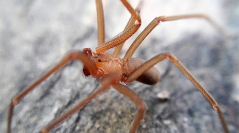

 European Journal of Taxonomy
2020 (704) - Pages 1-30
European Journal of Taxonomy
2020 (704) - Pages 1-30Based on an integrative taxonomic approach, a new species of the genus Loxosceles Heineken & Lowe, 1832, is described from the state of Hidalgo, Mexico. Loxosceles tolantongo sp. nov. is described based on DNA barcoding using cytochrome c oxidase subunit 1 (CO1) and internal transcribed spacer 2 (ITS2), and morphology. For species delimitation, four molecular methods were implemented: 1) corrected p-distances under neighbor joining (NJ); 2) automatic barcode gap discovery (ABGD); 3) general mixed yule coalescent model (GMYC) and 4) Bayesian Poisson tree processes (bPTP). The new species morphologically resembles L. jaca, another species from Hidalgo, but there are morphological differences mainly in the tibiae of the male palp, the seminal receptacles of the females and also the high genetic p-distances. CO1 was more informative than ITS2 for the genetic separation; however, both concatenated genes (CO1 + ITS2) present robust evidence for species delimitation. Loxosceles tolantongo sp. nov. is considered a unique species for four reasons: 1) it can be diagnosed and distinguished by morphological characters (of the male palps mainly, but also of the seminal receptacles of the females); 2) the genetic p-distances with CO1 were high (>10%); 3) the molecular species delimitation methods were congruent under CO1 and CO1 + ITS2; and 4) under CO1 and CO1 + ITS2, the new species is a putative sister group of L. jaca + L. tenango.
Integrative taxonomy, molecular markers, Synspermiata, species delimitation, Hidalgo